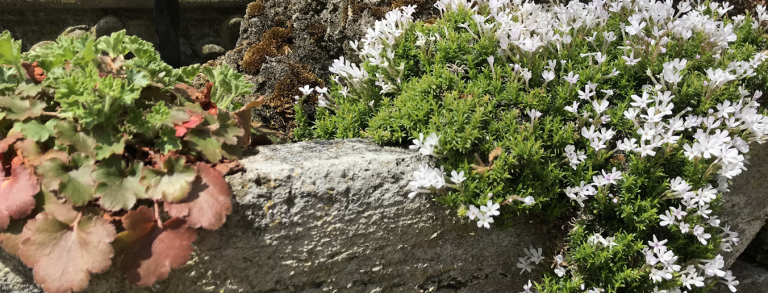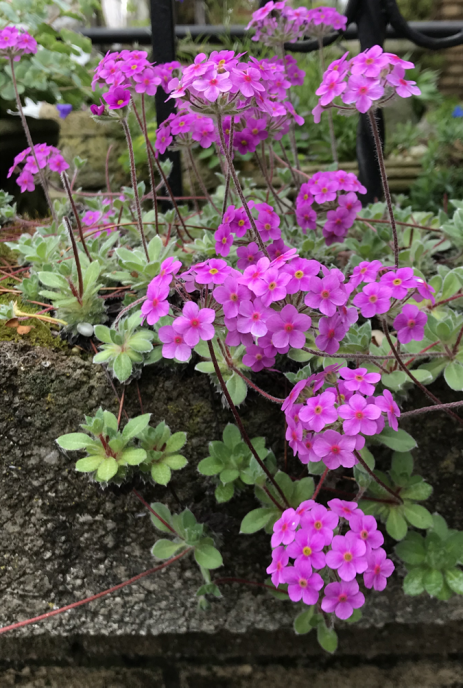I’M ALWAYS AMUSED by articles on “small gardens” which invariably feature a plot around the size of a small suburban yard. In Brooklyn, we know small, as in truly tiny or postage-stamp sized. Those of us in New York City and other dense urban environments are happy to have any outdoor space at all and try to make full use of it, tucking pots, troughs and other containers full of treasures into every available space.
To that end, after I joined NARGS and our local Manhattan Chapter, I began to set up troughs along the narrow edge of the wall next to my driveway in the front of my house, and this became my Alpine Zone. With full sun through winter and spring and dappled sun in summer and fall, I grow traditional rock garden plants here, for the most part those that can take a bit of shade. The troughs vary a bit in size and shape but have to fit along the brick ledge. Other pots and troughs perch on the wall by the steps to our porch.
Our springs here in Brooklyn can be cold and wet, and some plants that are looking good in winter succumb in spring. An open-but-covered front porch and single-specimen pots enable me to move these touchy plants out of the damp so they still get sun and cold but only as much moisture as I provide. I’m lucky enough to have several beautiful pots made by Larry Thomas, the founder of our chapter. These I generally reserve for single specimens such as Verbascum ‘Letitia’, one of the plants that get front porch winter protection.
Since I’m in NARGS, I of course want to grow plants that are native to habitats far from Brooklyn, or treasures that I’ve seen and lusted after in gardens at AGMs or on NARGS tours. I grew Salix x boydii in a too-small pot in my garden and it succumbed to the heat of a Brooklyn summer in its second year. I then saw it growing beautifully in every garden we visited on the NARGS Scotland tour so I will of course try it again, but this time in a deeper, cooler pot, and a location with more shade in summer.
Woody plants are a love of mine, but even small varieties of larger shrubs can get too big too fast. Some daphnes and rhododendrons are either small enough for a trough or pot or can be kept small by pruning. (Note, however, that I suspect my second-season Daphne x napolitana ‘Bramdean’ will outgrow its pot in another year or two.)
A Japanese maple given a rudimentary bonsai treatment will stay small, as will a Japanese maple with naturally short internodes. And of course, there’s Ulmus parvifolia ‘Hokkaido’, also known as lazy man’s bonsai. A mature specimen in a trough at Wave Hill (a public garden in the Bronx) whetted my appetite for this tiny tree. My Ulmus ‘Hokkaido’ is in a newly planted container in front of the house, with Rhododendron ‘Wren’, Rhododendron sargentianum, a seedling Hepatica nobilis, and Houstonia caerulea, which generally resists my efforts to plant it, but seeds around gently where happy. Thalictrum kiusianum, a placeholder for to-be-sourced Salix x boydii, rounds out the plantings in this pot. This is one of my attempts at a crevice garden—no heavy equipment needed.
Moving to the back of the house, there are areas of both shade and sun through most of the year but in winter and early spring the garden is generally shaded by my house and adjoining houses. A couple of pots are positioned to take advantage of the very limited sun. I grow only a few traditional rock garden plants in the back garden, but daphnes, some gentians, and a few others seem to be able to put up with these conditions.
Another interest, and one that’s well suited to containers, is bog gardens. Yes, this was spurred on by NARGS field trips at AGMs in North Carolina and Newfoundland. I use a 50/50 mix of sand and peat, in a container lined with a double layer of heavy-duty, black plastic contractor’s trash bag. Slits are cut a couple of inches from the top so that the container has a bit of drainage but generally stays quite wet. A nameless sarracenia, Drosera capensis, and Vaccinium macrocarpon ‘Hamilton’ have been happy in this pot for years. Having Salix repens ‘Iona’ in this container lets me get up close to its wonderful twisty branches. Nearby, I’ve just added Calopogon tuberosus to a pot of Sarracenia ‘Mardi Gras’. Orchids are always welcome!
And last, a bit of serendipity in the garden. This round pot was once filled with plants whose names are lost in the mists of time. Houstonia caerulea decided that pot was just the ticket, quickly filled it, and has lived there happily for years now. I look forward to its sea of pale blue every spring.


